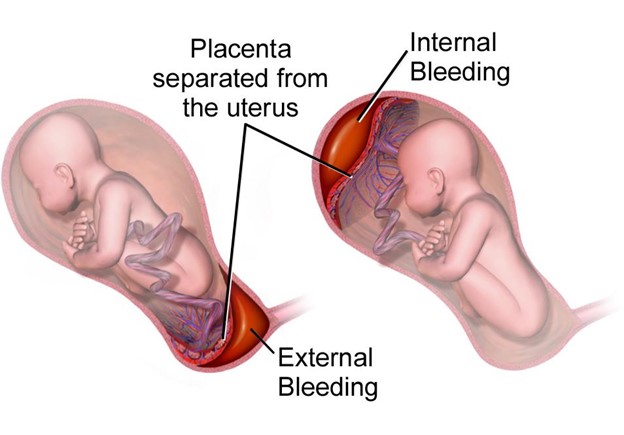A nurse is caring for a client who is at 38 weeks of gestation and is experiencing continuous abdominal pain and vaginal bleeding. The client has a history of cocaine use. The nurse should identify that the client is likely experiencing which of the following complications?
Abruptio placentae.
Hydatidiform mole.
Preterm labor.
Placenta previa.
The Correct Answer is A
Choice A rationale:

Continuous abdominal pain and vaginal bleeding in a client with a history of cocaine use are indicative of abruptio placentae. Abruptio placentae is a medical emergency where the placenta detaches from the uterine wall before delivery, leading to severe bleeding and abdominal pain. Immediate medical intervention is necessary to prevent complications for both the mother and the baby.
Choice B rationale:
Hydatidiform mole is a gestational trophoblastic disease that occurs due to an abnormal pregnancy. It is not associated with continuous abdominal pain and vaginal bleeding. Instead, clients with this condition often present with vaginal bleeding and a grape-like cluster of cysts in the uterus.
Choice C rationale:
Preterm labor involves regular uterine contractions and cervical changes before 37 weeks of gestation. While preterm labor can cause abdominal discomfort, it is not usually described as continuous abdominal pain. Vaginal bleeding is not a typical symptom of preterm labor.
Choice D rationale:
Placenta previa is a condition where the placenta covers the opening of the cervix. It can cause painless vaginal bleeding, but it is not usually associated with continuous abdominal pain. Clients with placenta previa often experience sudden, painless bleeding later in pregnancy.
Nursing Test Bank
Naxlex Comprehensive Predictor Exams
Related Questions
Correct Answer is B
Explanation
Choice A rationale:
High calcium levels are not typically associated with the use of anastrozole, an aromatase inhibitor. Aromatase inhibitors work by blocking the conversion of androgens to estrogens, and they do not directly impact calcium levels.
Choice B rationale:
Muscle and joint pain is a common side effect of aromatase inhibitors like anastrozole. These medications can lead to musculoskeletal discomfort, including joint stiffness and pain, which the nurse should inform the client about to ensure she is aware of potential adverse effects.
Choice C rationale:
Heart failure is not a known side effect of anastrozole. The drug's primary concern is its impact on the musculoskeletal system, particularly causing joint and muscle pain.
Choice D rationale:
Polyphagia, which refers to excessive hunger and increased food intake, is not associated with the use of anastrozole. This choice is unrelated to the side effects of the medication and can be ruled out.
Correct Answer is B
Explanation
Choice A rationale:
Hypotonicity, or decreased muscle tone, is not an expected finding in a newborn experiencing opioid withdrawals. Opioid withdrawal symptoms usually involve increased muscle tone and jitteriness.
Choice B rationale:
Moderate tremors of the extremities are an expected finding in a newborn experiencing opioid withdrawals. Neonates born to mothers who used opioids during pregnancy can exhibit tremors, irritability, and other withdrawal symptoms.
Choice C rationale:
An axillary temperature of 36.1°C (96.9°F) is within the normal range for a newborn's body temperature, so it is not directly related to opioid withdrawal and is not the expected finding in this situation.
Choice D rationale:
Excessive sleeping is not an expected finding in a newborn experiencing opioid withdrawals. Opioid withdrawal can lead to increased wakefulness and irritability in newborns.
Whether you are a student looking to ace your exams or a practicing nurse seeking to enhance your expertise , our nursing education contents will empower you with the confidence and competence to make a difference in the lives of patients and become a respected leader in the healthcare field.
Visit Naxlex, invest in your future and unlock endless possibilities with our unparalleled nursing education contents today
Report Wrong Answer on the Current Question
Do you disagree with the answer? If yes, what is your expected answer? Explain.
Kindly be descriptive with the issue you are facing.
